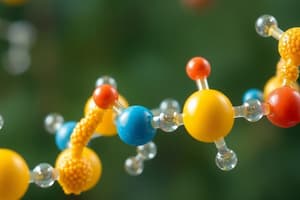Podcast
Questions and Answers
What are carbohydrates also known as?
What are carbohydrates also known as?
- Amino acids
- Monosaccharides (correct)
- Lipids
- Fatty acids
Which of the following is a type of lipid?
Which of the following is a type of lipid?
- Fatty acids (correct)
- Amino acids
- Nucleotides
- Monosaccharides
Proteins are made up of what building blocks?
Proteins are made up of what building blocks?
- Monosaccharides
- Fatty acids
- Nucleotides
- Amino acids (correct)
Nucleic acids are composed of which of the following?
Nucleic acids are composed of which of the following?
List the four organic molecules.
List the four organic molecules.
What are examples of simple sugars?
What are examples of simple sugars?
What is a triglyceride composed of?
What is a triglyceride composed of?
What do fatty acids consist of?
What do fatty acids consist of?
What is a disaccharide?
What is a disaccharide?
Function of monosaccharides?
Function of monosaccharides?
What is hydrolysis?
What is hydrolysis?
What is the main function of lipids?
What is the main function of lipids?
Define a peptide bond.
Define a peptide bond.
What is the definition of proteins?
What is the definition of proteins?
What are the monomers that build phospholipids?
What are the monomers that build phospholipids?
Match the following types of structures to their descriptions:
Match the following types of structures to their descriptions:
Flashcards are hidden until you start studying
Study Notes
Carbohydrates
- Monosaccharides are the simplest form of carbohydrates, typically represented by the chemical formula CH₂O.
- Disaccharides consist of two monosaccharides linked by a glycosidic bond formed through dehydration synthesis.
- Polysaccharides, such as starch and cellulose, are long chains of monosaccharides serving as energy storage or structural support.
- Common monosaccharides include glucose, galactose, and fructose.
Lipids
- Fatty acids are key components of lipids, characterized by long hydrocarbon chains.
- Lipids are hydrophobic, meaning they do not mix with water and are essential for storing energy and insulating the body.
- Different types of fatty acids include saturated (maximum hydrogen atoms, no double bonds) and unsaturated (contain one or more double bonds).
- Triglycerides are glycerol molecules bound to three fatty acids, forming the main form of dietary fat.
Proteins
- Proteins are polymers built from amino acids, which have a carboxyl group, an amino group, and an R (side chain) group.
- Amino acids are linked together by peptide bonds, forming polypeptides that can fold into various structures.
- Protein structures are categorized into four levels: primary (sequence of amino acids), secondary (local folding), tertiary (3D structure), and quaternary (multiple polypeptides).
- Proteins function in various roles including structural components, enzymes, and hormones.
Nucleic Acids
- Nucleotides, the monomers of nucleic acids, consist of a nitrogenous base, a pentose sugar, and a phosphate group.
- There are two types of nitrogen bases: pyrimidines (single-ring structures) and purines (double-ring structures).
- Nucleic acids include DNA and RNA, which are vital for genetic information storage and transfer.
Macromolecules
- Organic molecules encompass carbohydrates, lipids, proteins, and nucleic acids.
- Macromolecules are typically formed through the polymerization of smaller units known as monomers.
- Dehydration synthesis involves combining monomers, releasing water, while hydrolysis breaks down macromolecules, requiring water.
Miscellaneous Concepts
- Glycosidic linkage is the bond formed between monosaccharides during the creation of disaccharides or polysaccharides.
- Hydrolysis is the chemical process that breaks down macromolecules into their monomer components.
- Polymers are large molecules made from repeating structural units (monomers), essential for building biological structures.
Important Definitions
- Hydrophobic: Refers to substances that repel water, significant in the context of lipid behavior.
- Peptide bond: A covalent bond linking amino acids, crucial for forming proteins.
- Condensation reaction: A reaction that removes water to combine smaller molecules, important in forming macromolecules like carbohydrates and proteins.
Studying That Suits You
Use AI to generate personalized quizzes and flashcards to suit your learning preferences.




